Daily routines can feel less overwhelming when your bathroom offers the calm of a luxury spa. With stress and screen fatigue on the rise, homeowners are turning ordinary bathrooms into peaceful wellness retreats that soothe the mind and reset the body. From rainfall showers and natural textures to warm lighting and tranquil layouts, spa-inspired bathrooms deliver more than aesthetic value—they promote mental clarity and better rest. This guide breaks down the most effective design ideas that feel indulgent yet achievable in everyday homes. Whether you’re renovating fully or updating key elements, you’ll find expert-backed ways to make relaxation part of your space.
Marble and Metallic Accents

Polished stone finishes paired with metallic elements introduce a luxe dimension to spa-style bathrooms. Marble, with its smooth veining and cool touch, lends itself naturally to serene environments. When partnered with brushed gold, polished nickel, or matte black hardware, the contrast exudes quiet sophistication. The trick lies in subtlety—marble wall cladding or countertops should serve as a calming backdrop rather than a showpiece. Avoid high-gloss finishes in favor of honed or satin textures that soften the look. Meanwhile, metallic accents in faucets, mirror frames, or towel bars add structured detail without overpowering. To maintain balance, limit metal tones to one or two throughout the space. For added interest, consider pairing white or gray marble with champagne bronze for a soothing yet modern twist. Marble’s durability also makes it ideal for wet environments, ensuring both beauty and performance over time. For a contemporary spa vibe, this pairing offers timeless appeal.
Tile Drenching
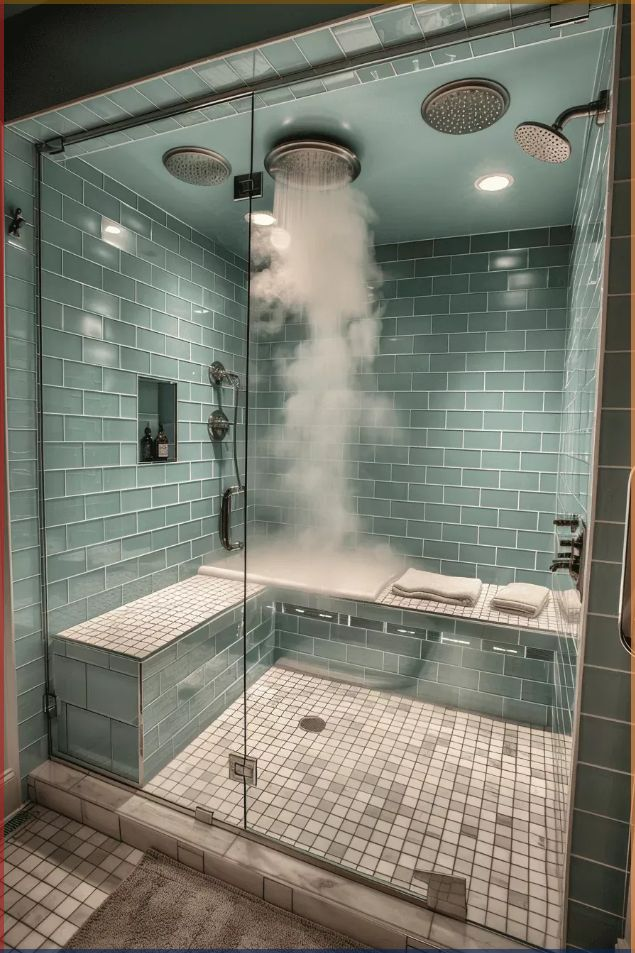
Walls and floors drenched in a single tile type create seamless flow that defines the spa bathroom aesthetic. Tile drenching involves extending tile beyond expected boundaries—enveloping floors, walls, and even ceilings in the same material or tone. This tactic fosters visual calm and continuity, reducing visual clutter and promoting relaxation. Matte porcelain or large-format ceramic tiles are ideal for this application, especially in muted shades like sand, pale gray, or off-white. Consider pairing with linear drains and frameless glass to allow the material to shine uninterrupted. For added depth, incorporate subtle textures or tonal variations within the tile design. Even a soft terrazzo or concrete-look tile can offer enough movement while keeping the look tranquil. This method doesn’t just unify the design—it also adds a water-resistant, easy-to-clean finish throughout. In homes aiming for a spa-inspired retreat, tile drenching delivers practical elegance rooted in minimalism and harmony.
Natural Wood Paneling

Warmth and earthiness come to life through natural wood paneling, a feature that fosters an instant sense of calm. When used judiciously, wood walls lend rustic charm without disrupting the spa-like energy. Opt for moisture-resistant species like teak, cedar, or thermally treated ash to withstand humidity while maintaining their beauty. Horizontal or vertical planking creates architectural rhythm, while light stains enhance the organic grain. For modern settings, slatted wood panels introduce texture and sound diffusion—ideal for echo-prone bathrooms. Whether covering a full accent wall or forming part of a built-in bench or vanity surround, wood adds grounding contrast to sleek tile or stone. Pairing this material with hidden LED lighting amplifies the cozy ambiance. Careful sealing ensures longevity, and regular oiling preserves its tone. When curated with intention, wood paneling offers warmth, character, and a deep connection to nature—hallmarks of spa-inspired interiors.
Integrated Living Spaces
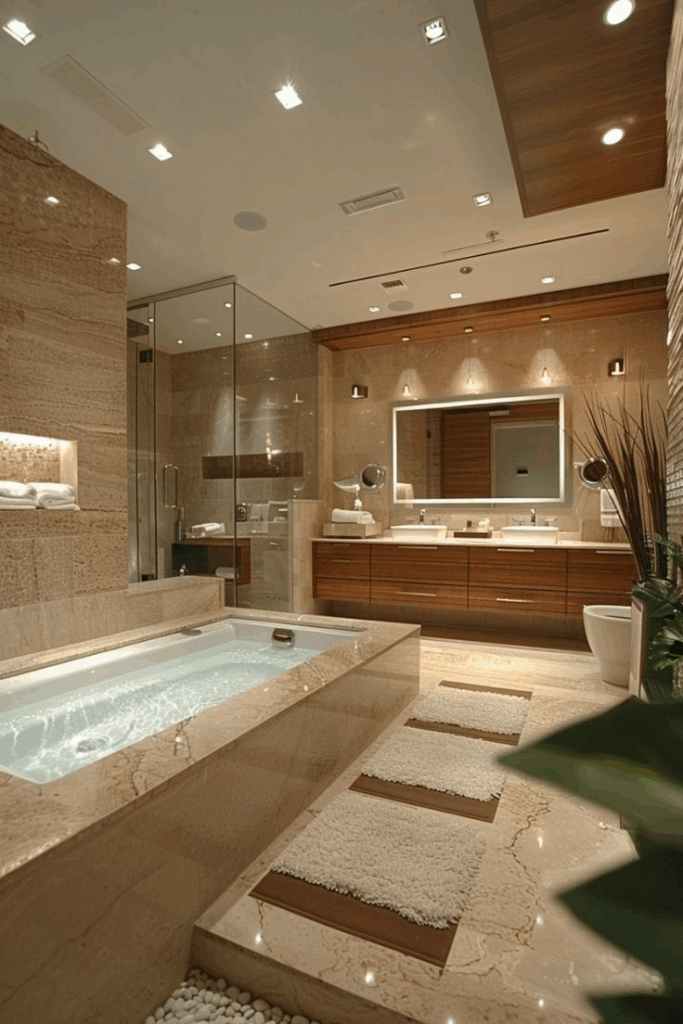
Blurring the line between bathing and lounging zones redefines how we perceive bathroom spaces. Integrated living spaces combine spa features with lifestyle functionality, allowing comfort and utility to coexist. Think built-in seating beside freestanding tubs, or vanity areas that double as makeup desks or journaling nooks. These multi-use areas support relaxation without sacrificing performance. Materials used in adjoining rooms—like wood flooring or soft textiles—can extend into the bathroom to create visual cohesion. Large sliding doors or glass partitions allow for openness while still providing separation when needed. Integrating a fireplace, reading nook, or meditation cushion enhances the sense of retreat. Designers often rely on low furniture profiles, minimal color palettes, and organic shapes to create a living space that doesn’t feel sterile. The shift toward integrated layouts reflects how self-care is becoming an everyday lifestyle choice rather than an occasional indulgence.
Avocado Green Accents
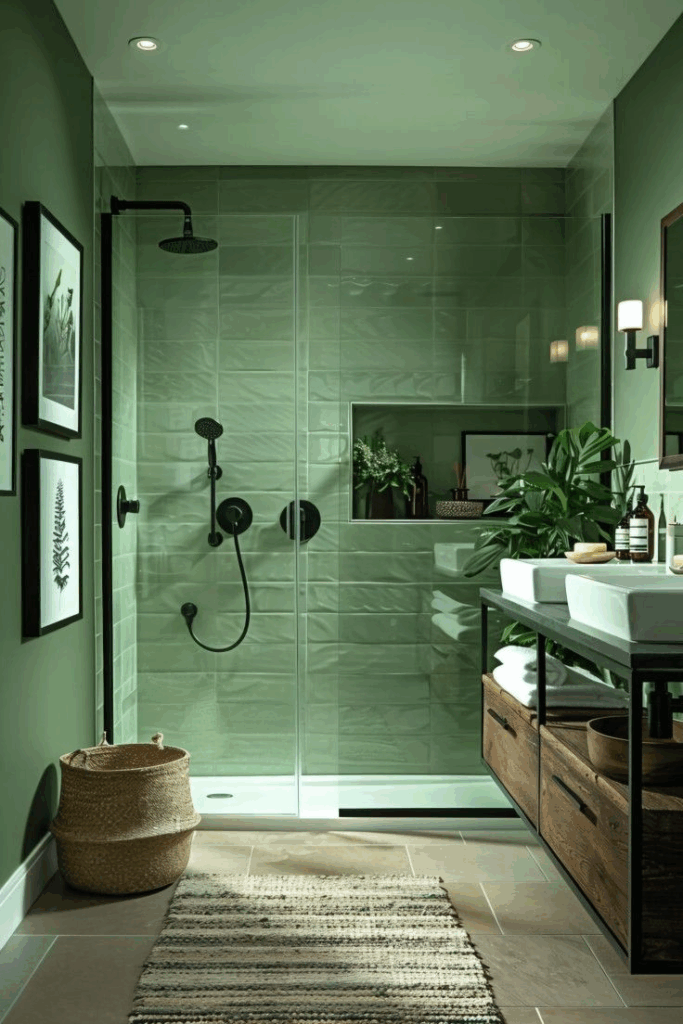
This unexpected yet nostalgic color is enjoying a resurgence in wellness-focused spaces. Avocado green, once a retro kitchen staple, is now being used in spa bathrooms to evoke renewal and serenity. Whether in glazed tile, painted cabinetry, or natural stone with green undertones, the hue connects interiors to foliage and earth. It’s especially effective when balanced with off-whites, natural wood, or textured neutrals that let the green breathe. Designers often limit it to focal points—like a vanity base or accent wall—to prevent overwhelm. In bolder applications, green terrazzo or ombré mosaic tiles create depth while maintaining calm. For added dimension, layering varying shades of green—olive, sage, eucalyptus—produces a soothing gradient effect. The emotional impact of this hue cannot be understated; green has been proven to reduce stress and promote calm. Avocado green accents speak to biophilic design principles, linking well-being with visual harmony.
Aromatherapy Features
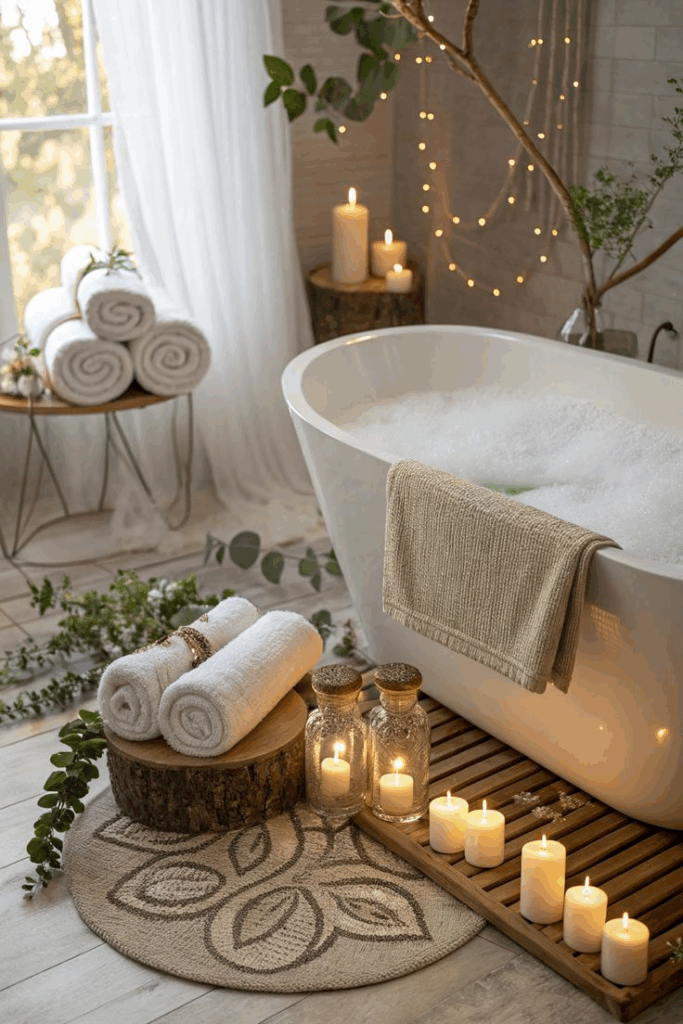
Wellness goes beyond visuals, and aroma plays a key role in shaping the spa experience. Aromatherapy features, such as built-in diffusers, essential oil niches, and eucalyptus bundles in showers, infuse the environment with therapeutic scent. Lavender encourages relaxation, peppermint invigorates, and eucalyptus clears the senses. High-end spa bathrooms often include heated towel racks that enhance essential oil diffusion when infused towels are used. Even showerheads are now available with aroma pods to disperse fragrance with steam. Scented candles or handmade soap collections elevate the olfactory experience further. For a low-maintenance solution, dried lavender or citrus peels in woven baskets offer passive scent release without artificial additives. Proper ventilation is essential to allow aromatic elements to flow without becoming overpowering. When thoughtfully integrated, aromatherapy transforms a standard washroom into a multisensory haven where stress naturally dissolves.
Freestanding Soaking Tubs
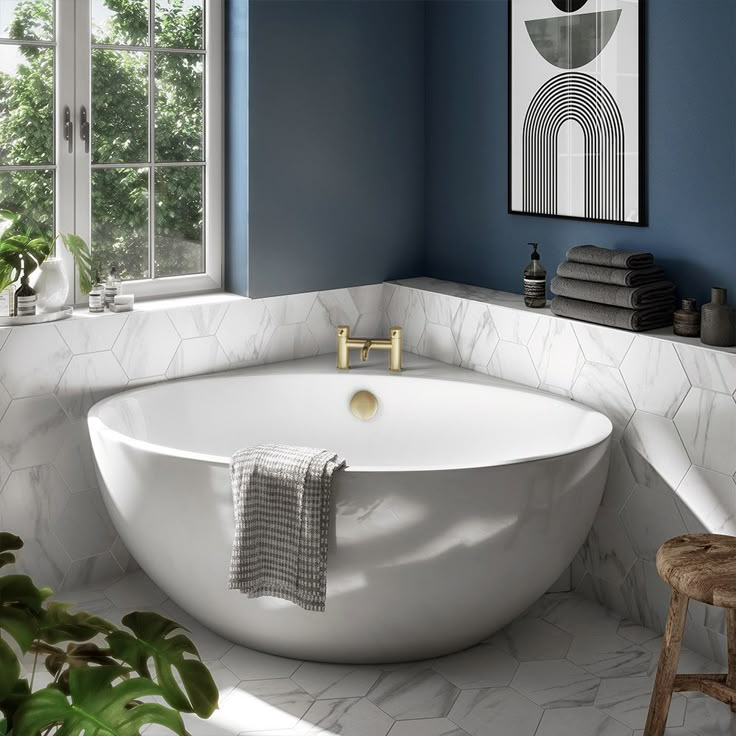
Soaking tubs remain a signature feature in spa-inspired design, offering the ultimate in relaxation. Freestanding varieties, in particular, serve as sculptural focal points while providing full-body immersion. Unlike traditional alcove tubs, freestanding models can be positioned to optimize light and view—be it near a window, beneath a skylight, or beside a feature wall. Material choices range from cast stone and resin to copper and matte-finish acrylic, each contributing its own texture and warmth. Curved silhouettes are preferred for their ergonomic support and visual softness. To elevate the experience, many homeowners install floor-mounted tub fillers with hand showers or incorporate tray tables for bath salts, books, or wine. Placement on a tiled platform or pebbled floor further enhances the sanctuary effect. Whether modern or classic in form, these tubs promote stillness and ritual, inviting extended moments of solitude and calm.
Ambient Lighting

Lighting strategy can make or break the soothing mood in a bathroom. Ambient lighting focuses on soft, diffused glow that reduces harsh shadows and enhances relaxation. This includes wall sconces with frosted globes, LED cove lights, and dimmable ceiling fixtures. Layering sources—overhead, mirror-backlit, and under-vanity lights—ensures versatility for both functional and tranquil moments. Color temperature plays a crucial role; opt for bulbs between 2700K to 3000K to mimic warm daylight. Integrating motion sensors can enhance ease of use during early mornings or nighttime visits. For added atmosphere, pendant lights in natural textures like linen or rattan soften the space while aligning with spa aesthetics. Concealed light strips along architectural details subtly define edges without overpowering. Whether used to start a slow morning or unwind before bed, ambient lighting establishes the emotional rhythm of the space.
Natural Materials
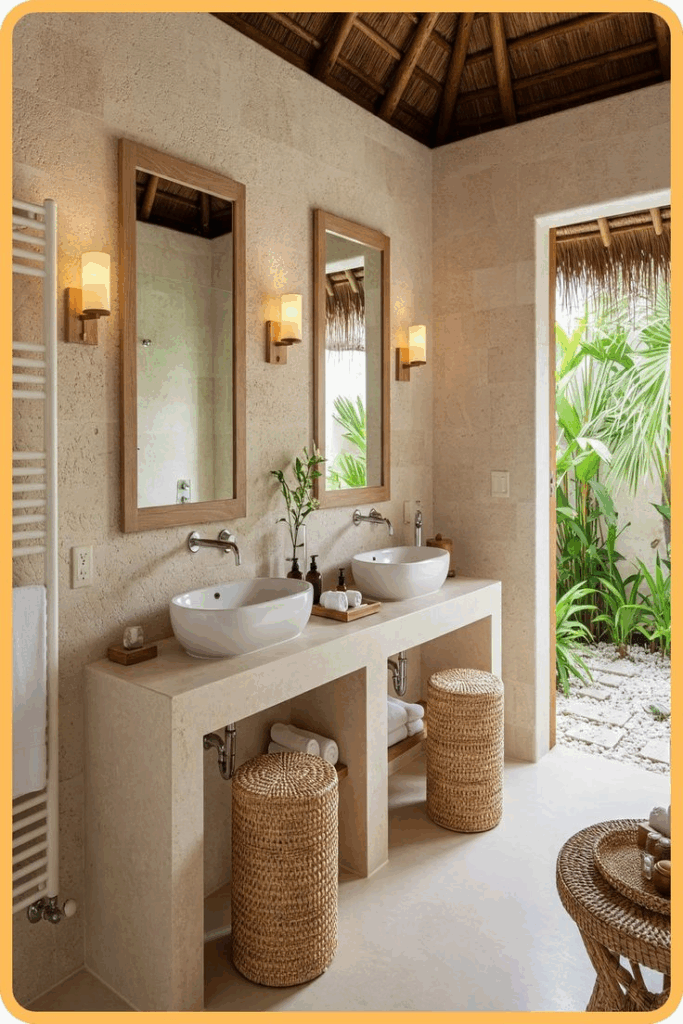
Organic finishes, muted tones, and breathable materials establish a grounded sense of comfort in spa bathrooms. Natural elements—such as stone, linen, jute, bamboo, and clay—reinforce the connection to earth and wellness. Instead of polished perfection, these textures celebrate imperfections: raw edges on wooden stools, hand-thrown ceramics by the sink, and uneven tile patterns that feel handmade. Linen curtains filter natural light while contributing softness. Stone basins and travertine countertops add durability alongside tactile charm. Even accessories matter—think soap dishes carved from reclaimed wood or planters woven from seagrass. Every choice signals care for both design and environment. Opting for natural materials isn’t purely aesthetic; it promotes indoor air quality and sustainability. These mindful design decisions promote a balanced environment where both mind and body can reset.
Minimalist Design
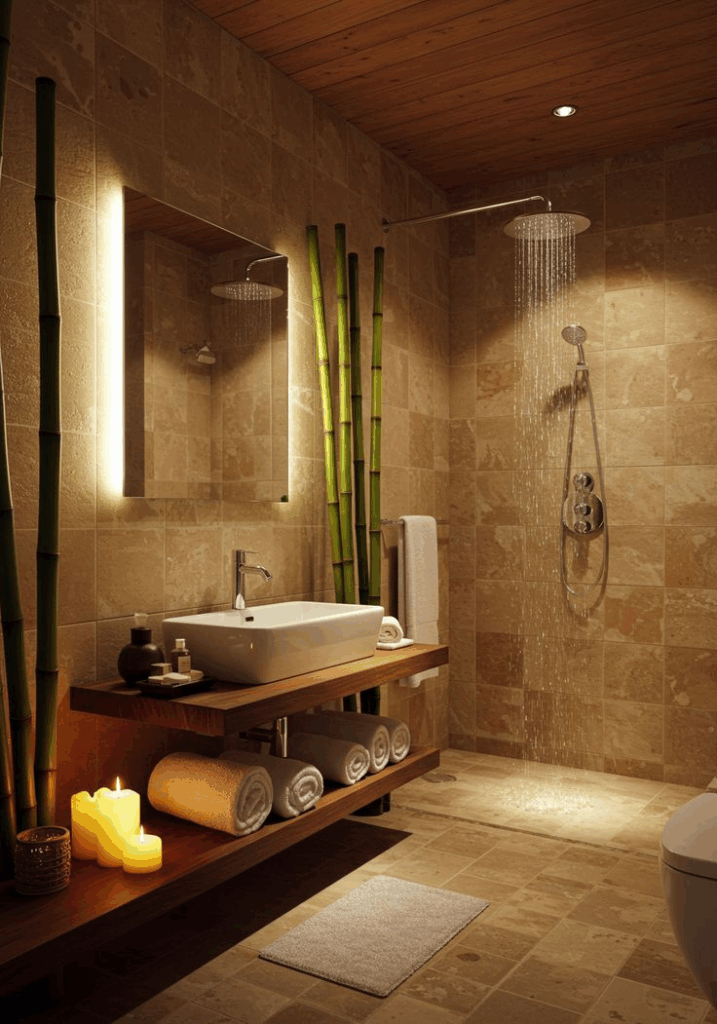
Understated elegance lies at the heart of spa bathroom aesthetics, and restraint is key to achieving it. Clean lines, open space, and a limited color palette allow architectural and material beauty to shine. Fixtures tend to be simple yet highly functional—floating vanities, wall-mounted faucets, and frameless glass enclosures are favored. The visual hierarchy is controlled, allowing the eyes to rest and the mind to relax. Hidden storage ensures that clutter remains out of sight, supporting a distraction-free environment. Rather than decorative overkill, interest comes from material contrast and thoughtful lighting. Tiles may feature subtle textures instead of bold patterns. Even towel hooks and drawer pulls are chosen for simplicity and cohesion. This design language doesn’t equate to sterility—instead, it encourages mindfulness by removing the visual noise. By emphasizing restraint and harmony, the space fosters a retreat-like quality grounded in purpose.
Indoor Plants
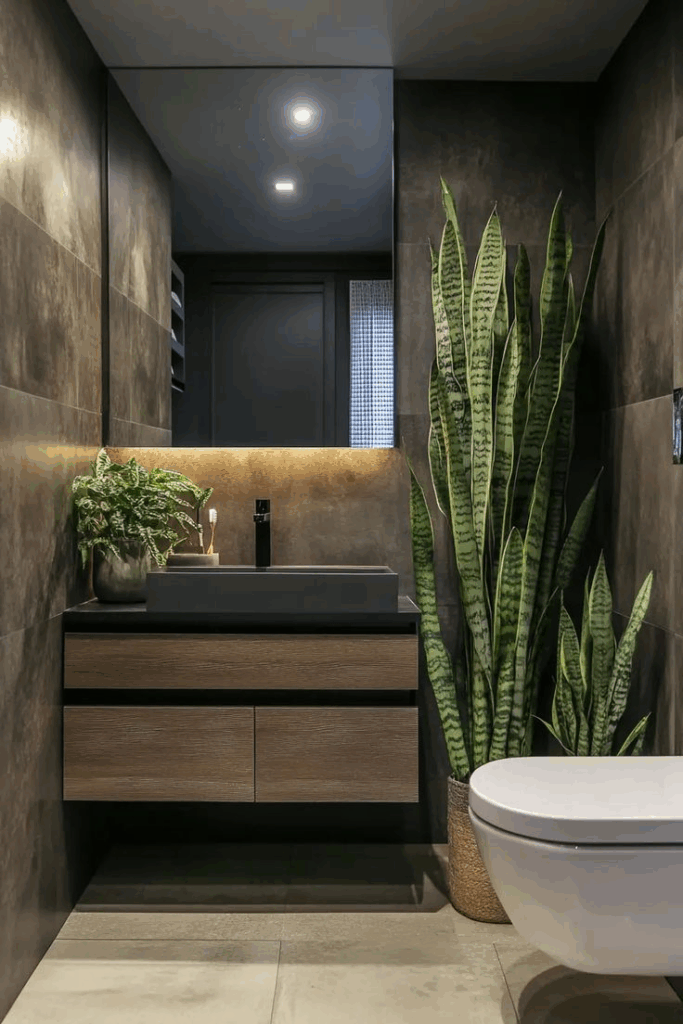
Greenery introduces vitality and a natural rhythm that resonates deeply in wellness-oriented design. Indoor plants purify the air, add softness to hard surfaces, and engage the senses. Popular choices for spa-style bathrooms include ferns, pothos, snake plants, and peace lilies—all of which thrive in low light and humid conditions. Hanging planters, wall-mounted pockets, or small potted arrangements on windowsills work well without taking up floor space. Bamboo ladders can double as towel holders and plant stands. Even a single oversized plant—like a fiddle leaf fig—can define a corner with serene elegance. To maintain a clean look, use uniform planters in muted tones or natural finishes. Introducing greenery isn’t only about appearance; plants play a psychological role by fostering calm and reducing stress. Integrating botanical life within the bathroom promotes a healthy, balanced experience rooted in nature.
Heated Flooring

Stepping onto warm floors after a bath or shower is a luxury rooted in function. Heated flooring enhances comfort while reducing the need for large radiators or forced air heating. Modern radiant systems use electric coils or hydronic tubes installed beneath tile, stone, or engineered wood flooring. Thermostats allow for precise control, including scheduling by time of day. This consistency in warmth contributes to the tranquil rhythm of a spa-like space. Heat also helps dry out ambient moisture, improving air quality and preventing mold growth. Many systems are energy-efficient and safe for wet areas, with waterproof membranes to guard against damage. Designers often pair heated floors with barefoot-friendly finishes such as matte porcelain or honed travertine. By keeping temperatures steady and surfaces cozy, heated floors subtly support a luxurious yet practical bathing experience.
Waterfall Showers
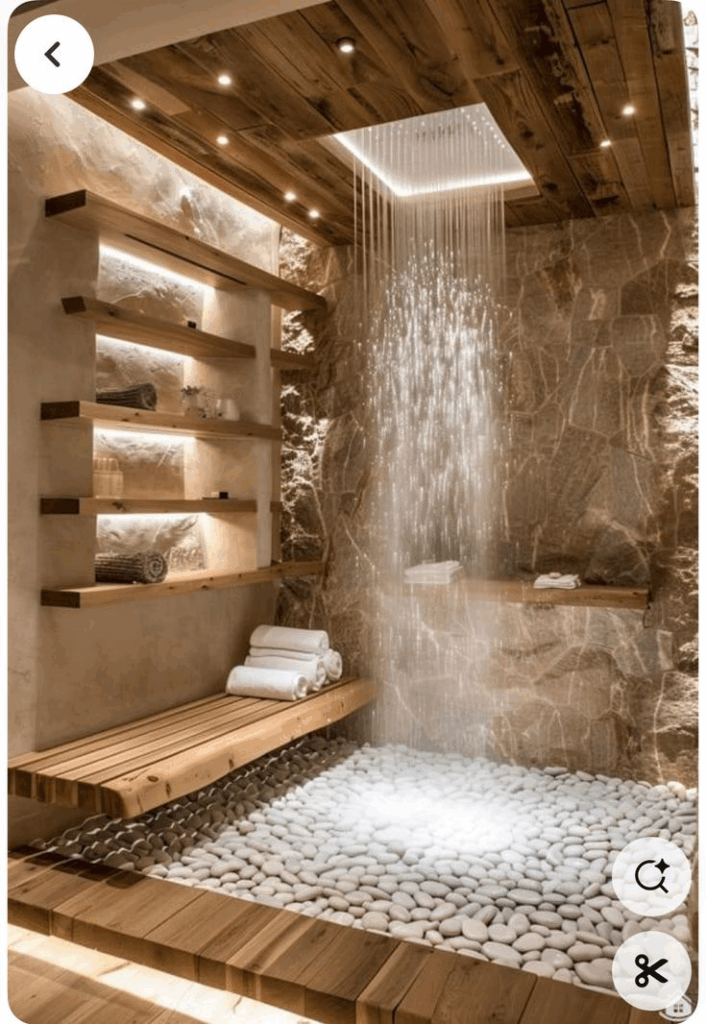
A rainfall effect cascading directly overhead can completely transform daily routines. Waterfall showers offer immersive sensory engagement, echoing the calming sensation of natural springs. Unlike angled nozzles, these fixtures are mounted flush to the ceiling or slightly recessed, allowing water to fall gently and evenly. The broad surface area ensures full-body coverage without the harshness of traditional spray. Popular materials include brushed nickel, matte black, and aged brass, selected to match other hardware seamlessly. Integrated LED lights or chromotherapy options introduce a spa-worthy upgrade, while thermostatic valves ensure consistent temperature throughout. For added indulgence, dual-function models allow switching between waterfall and handheld settings. Framing the shower in frameless glass or natural stone enhances the architectural drama. With the right planning, waterfall showers elevate bathing to a calming ritual steeped in nature-inspired luxury.
Textured Walls
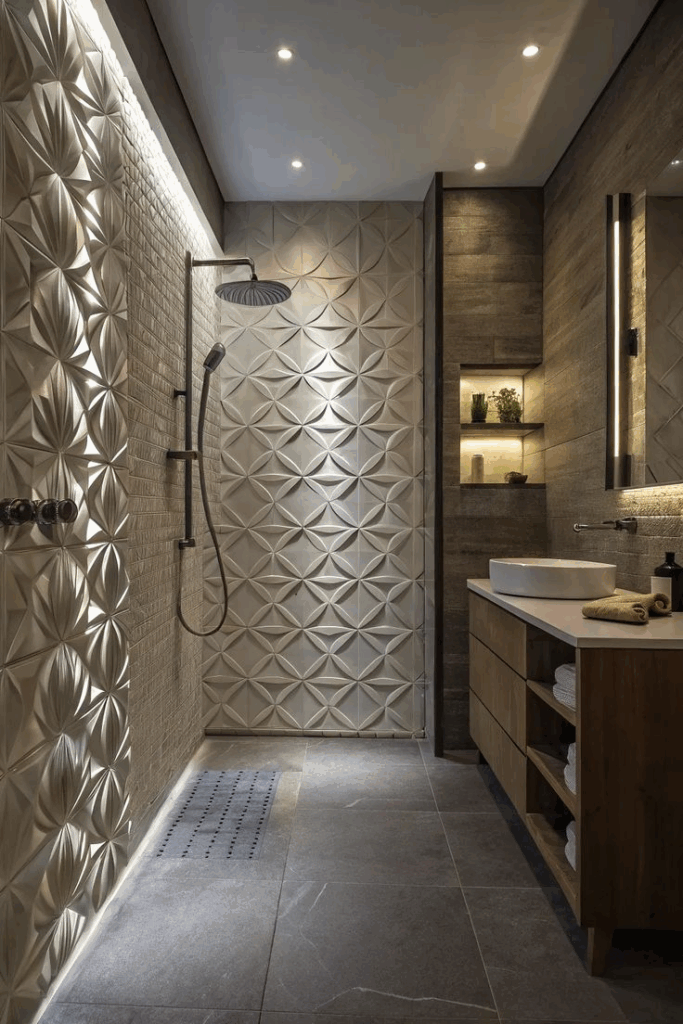
Textured walls introduce depth, tactility, and subtle drama that elevate spa bathrooms into multisensory experiences. Techniques range from limewash and Venetian plaster to ribbed wood slats and tile reliefs, offering both organic imperfection and visual richness. These finishes catch the light uniquely, shifting tone and shadow throughout the day to create a calming rhythm. Zellige tiles remain a favorite for their hand-cut edges and softly reflective surfaces that blur the line between refined and raw. In moisture-prone areas, microcement adds a seamless, sculptural quality while resisting mold and water damage. Applying texture strategically—such as on the vanity wall, shower enclosure, or alcove niche—allows dimension without visual overload. Earthy tones, soft curves, and intentional asymmetry enhance the grounding effect. These tactile elements go beyond aesthetics; they encourage touch and deepen the emotional connection to the space. In a bathroom designed for restoration, texture becomes a quiet, powerful presence.
Personalized Touches
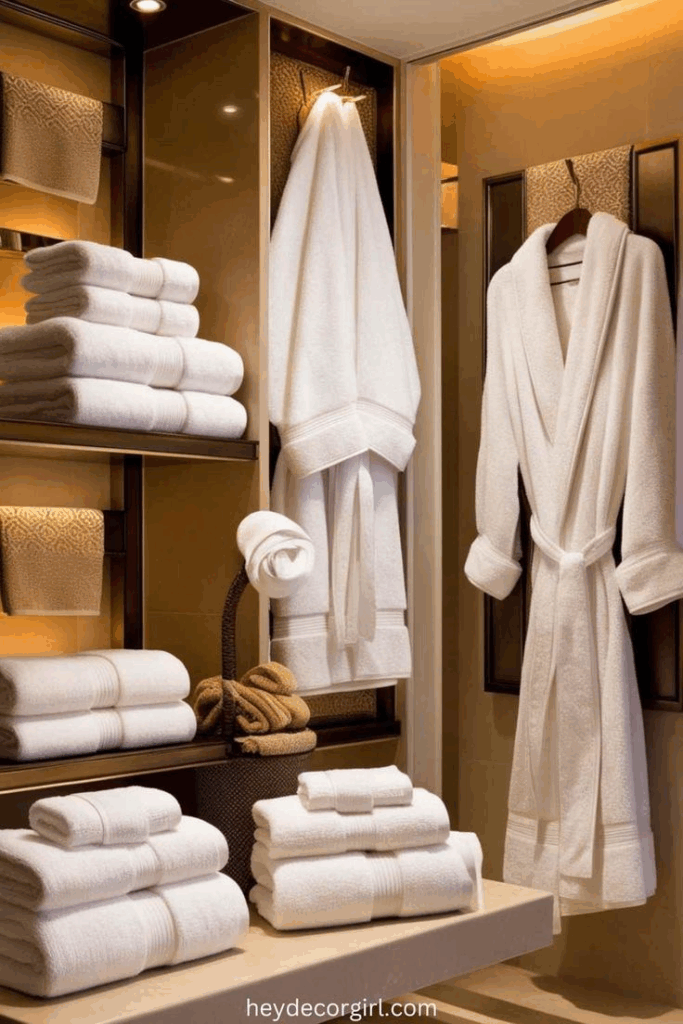
Details matter when crafting a wellness-oriented space. Personalized touches such as monogrammed towels, custom cabinetry inserts, or framed art infuse the bathroom with identity and care. Even functional elements can feel bespoke—think custom vanity mirrors with integrated lighting or handmade ceramic sinks. Storage solutions tailored to specific needs—like a drawer designed for aromatherapy oils or built-in cubbies for rolled towels—make everyday routines feel considered. Displaying curated collections of natural soaps, bath salts, or artisanal decor elevates the space without cluttering it. Color palettes can reflect personal style, whether rooted in coastal hues or desert tones. Sourcing from local artisans or using reclaimed materials also adds meaning. Ultimately, it’s these individual elements that transform a spa bathroom from a beautiful room into a deeply personal sanctuary aligned with lifestyle and taste.
